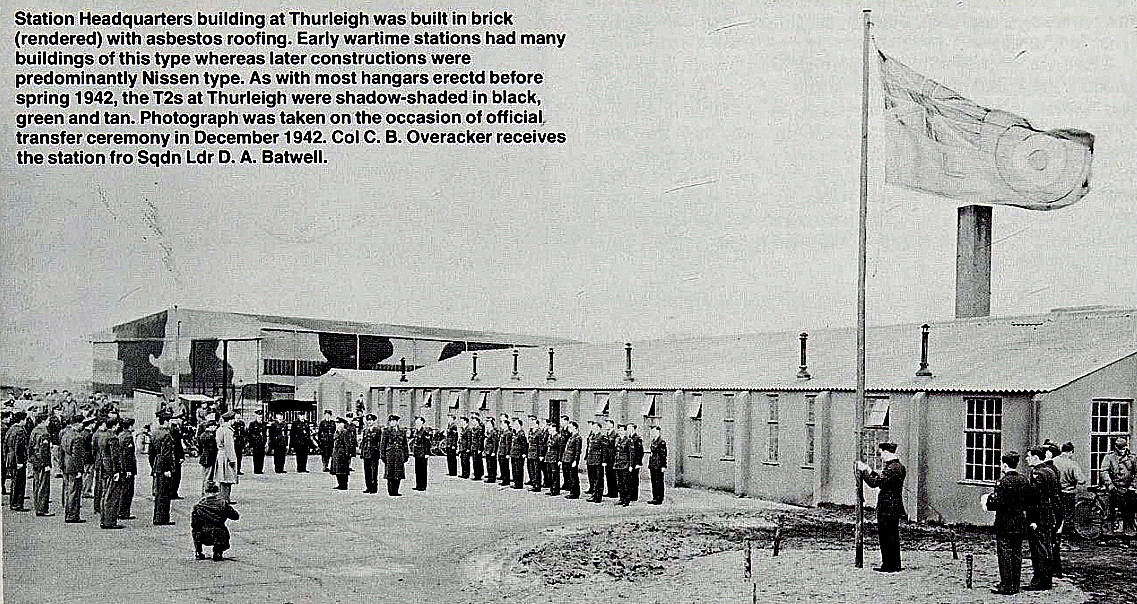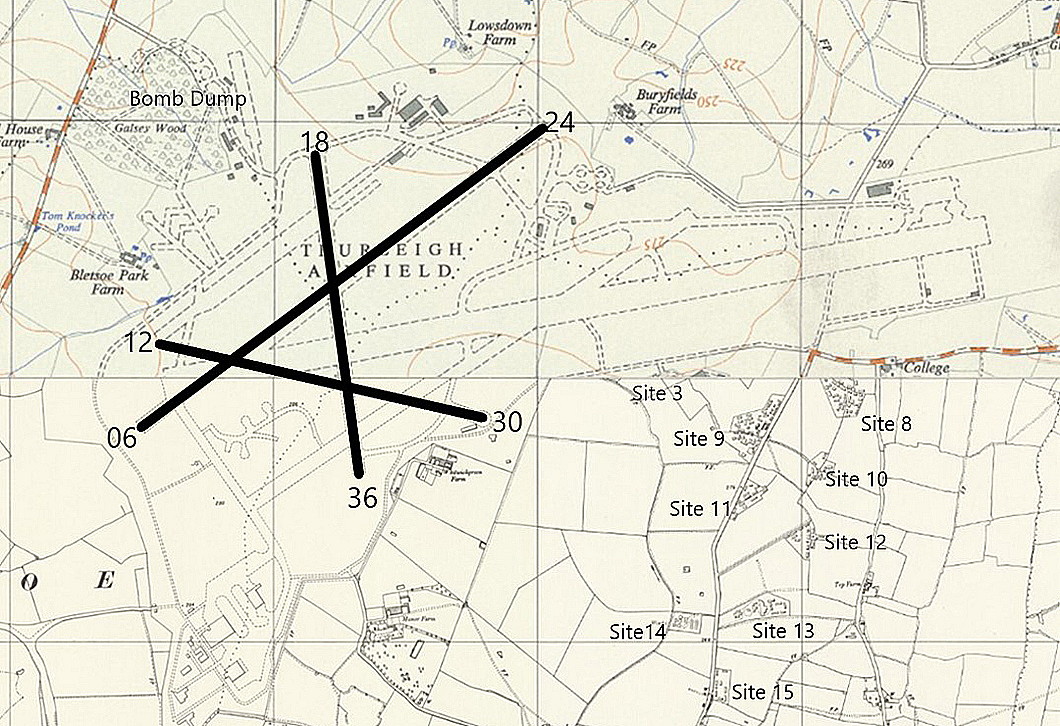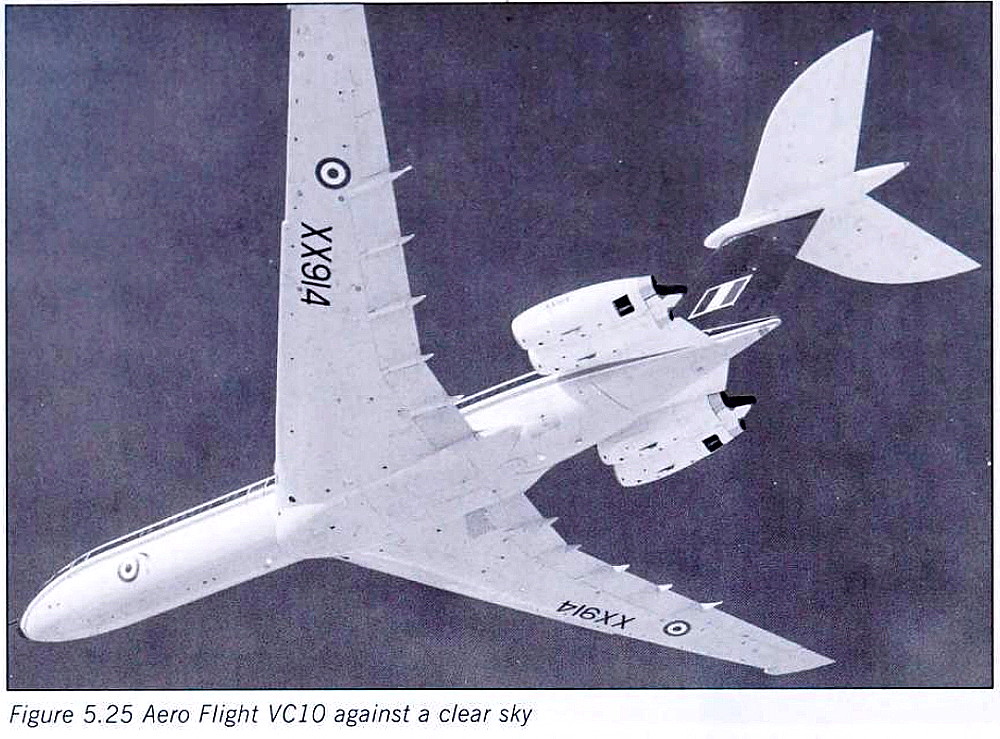Thurleigh
THURLEIGH: Military aerodrome later large flight test base
(Also known as BEDFORD and/or RAF BEDFORD. Plus, see also a seperate entry for BEDFORD AERODROME which has been established at the eastern end of this site)
Military users: WW2: Initially various RAF units until September 1942
8th USAAF 40th Bombardment Wing 306th Bomb Group
367, 368, 369 & 423 Sqdns ( 70 x Boeing B-17 Flying Fortress)
Post WW2: National Aeronautical Establishment, later Royal Aircraft Establishment, BEDFORD, finally Royal Aerospace Establishment, BEDFORD
'V' Bomber dispersal airfield
Sections: RAE Aerodynamics Flight Division (Aero Flight)
BLEU (Blind Landing Experimental Unit)
NAD (Naval Air Department)
Location: E of A6, 6nm N of Bedford
Period of operation: 1941 to 1994
Runways: WW2: 05/23 1829x46 hard 17/35 1280x46 hard
10/28 1280x46 hard
1950s: 09/27 3250x97 hard (Third longest runway in the UK)
06/24 2210x65 (parallel ‘catapault’ to the north) 18/36 runway rebuilt
NOTES: It seems that the 306th Bomb Group gained the honour of being the longest serving USAAF combat base in the UK. Arriving in September 1942 they eventually left in December 1945.
AMAZING PLANS
In 1943 it appears that plans were made for a massive site housing the National Aeronautical Establishement at THURLEIGH. Roughly ‘L’ shaped it included TWINWOOD FARM to the south and a five mile runway from THURLEIGH to LITTLE STAUGHTON was planned. Total cost, £18 million!
During occupation by the National Aeronautical Establishment, later to become the Royal Aircraft Establishment, possibly the biggest transformation of any WW2 aerodrome took place here. When the NAE/ Royal Aircraft Establishment was first formed and became operational at BEDFORD/THURLEIGH they certainly had an odd-ball selection of aircraft to play with in their early years. Types like the: Bristol Brigand, De Havilland Venom, Fairey Gannet, Grumman Avenger, Hawker Seahawk, Short Seamew, Supermarine 508 and Attacker and Westland Wyvern for fixed wing types plus the Westland-Sikorsky Dragonfly helicopter.
So typical of many other sites THURLEIGH/BEDFORD was deemed officially closed until it’s opening ceremony in 1957. Despite this official ‘oversight’ from 1954 over 10,000 aircraft movements were logged before THURLEIGH was renamed BEDFORD.
A VERY NOVEL AIRCRAFT
In 1957 arguably the most novel type of aircraft to be tested here, with a future potential to be eventually realised, albeit in a very different form, was the Short SC.1 VTOL experimental prototype. Two were ordered, XG900 and XG905. However, some say they were actually tested at BOSCOMBE DOWN. Something to be resolved? See below in the Michael T Holder Gallery.
The concept of a VTOL aircraft, as opposed to a helicopter, dates back many years before of course but it wasn’t until jet engines became available that idea could become a reality. To quote from Robert Jackson’s excellent book Britain’s Greatest Aircraft in the chapter concerning the Harrier and Sea Harrier: “The design submitted by Short Brothers, the PD.11 – small tailless delta aircraft with five Rolls-Royce RB.108 engines, four for lift and one for forward propulsion – was judged to be the most promising, and in August 1954 Shorts received a contract to build two prototypes under the designation Short SC.1.”
Hindsight is, as said elsewhere in this ‘Guide’ a most wonderful commodity, and I just wish I could bottle it and get supermarkets interested in selling it. I now wonder just how many people in 1954 saw the real future potential of the jet VTOL concept in those days? Following shortly after the end of WW2, when the UK was in a most dire situation economically, it seems nothing less than astonishing that so much was going on. But of course we now had a ‘Cold War’ to participate in and the British still clung on to obsolete ideas about still being a ‘World Power’ whilst all around the ‘Empire’ was collapsing. And yet, despite all this, we produced some of the most stunning aircraft ever seen in both the military and civil arenas.
Getting back to Robert Jackson: “The first SC.1, XG900, was initially not fitted with lift engines and made a convential maiden flight on 2 April 1957: it was the second prototype, XG905, which began tethered hovering trials in May 1958. On 6 April 1960, at the Royal Aeronautical Establishment (RAE) at Bedford, test pilot Tom Brooke-Smith achieved the first complete transition from level flight to vertical descent and vertical climb, following a conventional take-off. That summer, XG900 now having had its battery of lift engines fitted, both SC.1s developed short, rolling take-off techniques from unprepared surfaces, the objects of which were to avoid ground erosion and to allow flights at increased take-off weights.”
Test flying by the RAE took place here from 1957 until the 1990s, including ‘carrier’ deck landing tests and research for the Royal Navy including ‘ski-jump’ exercises for the Harrier ‘jump- jet. Some sources reckon this was first tried at DUNSFOLD? I'm fairly sure it wasn't?
In April 2022 I was kindly contacted by Mr James Davidson who tells us he was involved in the construction of a 'Caley Deck' around 1954/5, all in top secrecy. So, that adjusts the picture somewhat - the 'ski-jump' concept preceeding the Harrier.
PART OF CONCORDE TESTING
Possibly not much remembered today was that during the initial studies into the Concorde programme, two highly influential and individual aircraft were tested here in considerable detail, the HP.115 to explore the low speed characteristics, and the BAC 221, a modification of the World Record Breaking Speed Record Fairey Delta 2 for the 'Ogee' wing design for supersonic flight.
THE FIRST 'AUTOMATIC' LANDING
On the 5th March 1964 the second production Trident G-ARPB made the first ever fully automatic landing here using the Smith’s Autoland system. It is well worth looking deeper into the history of what went on here. The list of projects really is astonishing over the forty year history and many major aviation developments were first developed, tried and tested here.
A MICHAEL T HOLDER GALLERY
We have to thank Mike Holder, a great friend of this 'Guide', for delving into what is available today (2024) in various archives. When it comes to investigating archives, Mike is a meastro, in my opinion a wizard. Note, items from Wings Over Thurliegh by Mike D Dobson are just referred to as Wings Over Thurleigh. In the following I have made a clear distinction between the WW2 history and the later developments.
THE WW2 PHASE
The first photo of the B-17 is from the Mighty Eighth War Manual by Roger A Freeman, as are the next two pictures..
The USAAF were very keen to foster friendly relations with the local communities, despite their presence here being to make sure the war with Nazi Germany would be won. It came as a huge cost in all regards, not least of course the aircrew killed in both combat, and as illustrated here, just making a basic mistake after returning from a raid over Germany, no doubt very tired and probably relaxing somewhat once over friendly territory.
THURLEIGH COMES INTO ITS OWN
Being situated on top of a plateau, this location was ideal for top secret trials and experiments. Couldn't be seen from the surrounding ground. Often drove past on the A6 back in the day, and was barely aware of its existence, despite its considerable size. All the photos are from Wings Over Thurleigh by Mike D Dobson and, very roughly, more or less, in some kind of chronological order.
The local area view is from my Google Earth © derived database.
The first picture shows two Hawker Hunters, one DH112 Venom, a Gloster Meteor, the English Electric P1A prototype, and, the 'Flying Bedstead', the Rolls-Royce Thrust Measuring Rig, XJ314.
"The first jet-lift aircraft to fly anywhere in the world". Now on display in the Science museum in London. See my article on museums etc for a closer look.
DEVELOPING THE AUTOLAND SYSTEM
I think I am correct in thinking that the British were the first to develop an Autoland System? And look how that has turned out for, especially, the worlds airline industry. Have read an account of a BEA Trident first using this, very successfully at London Airport (now HEATHROW). Problem being that the 'Follow Me' van had some trouble in finding the way to the terminal. 'Urban myth' or factual?
Trying to be 'nerdy' and aspiring to become an 'anorak', it looks to me that the DH106 Comet is still wearing its BOAC colour scheme?
SOME MORE PICTURES
SUPERSONIC AND SUBSONIC FLIGHT RESEARCH FOR CONCORDE
A FEW MORE PICTURES
AND SOME MORE
The research aircraft in the 1983 photo were, from left to right, (basic models of course, and don't ask me for the exact type designations). A Westland Wessex, Harrier, BAC One-Eleven, Tornado, HS.125 and an Avro 748. But, what is that helicopter in the right hand lower quarter? I have no idea, but looks French to me.
ROUNDING OFF, BITS AND PIECES
When trying to make a listing, as extensive as this, often a few items remain that cannot be easily sorted out into various sections, Well, of course, they can, with seperate listings in the 'Guide', but I prefer to bundle them together. Reckon it looks more interesting?
The area view is from my Google Earth © derived database.
SPOTTERS NOTES
In 1977 the Auster J/5F Aiglet Trainer G-AMZT and Auster J/1N Alpha G-ASEE were based here.
It is reported that the last ever flight departed in 1994.
A MUSEUM
Today a part time museum is on this site. And, another it appears dedicated to the 306th Bomberdment Group.
Redeveloped as a business park in 1996 it is worth remembering that THURLEIGH was once regarded as a possible site for 3rd London Airport in the 1970s and a huge amount of local opposition resulted. As it turned out it was LUTON and STANSTED which became developed.
Terry Clark
This comment was written on: 2018-01-12 04:39:30Dr Jonathan Palmer, ex F1 racing driver, operates a racing driver training school on part of the airfield and connected with this, 1095m of the eastern end of runway 08/26 have been licensed to enable customers to fly in either in their own aircraft or in Dr Palmer's Kingair. Dr Palmer himself commutes daily from his helipad south of Gatwick in.
jhon bufton
This comment was written on: 2020-03-04 10:44:09In the 50's Thurleigh used to have open days and i remember seeing the 'Flying Bedstead' (Rolls Royce's Thrust Measuring Rig) maybe in 1953/54 ? the precursor of all vtol's. A truly wonderful contraption, looking at it you would think that thing will never fly - but it did!
Michael Holder
This comment was written on: 2020-05-14 12:22:19Dick, We used to practice dispersing in the 60s and 70s - Mickey Finn was the exercise - and then 3 or 4 days of getting called up to a high readiness we'd have the grand fly off which usually meant a low level attack against an airfield in Denmark/Germany/Holland etc before coming home for tea and medals. When I was at Wyton a little birdie told me that they left the crews who had dispersed to Bedford, on continual standby for 30 days to see how they would cope. A bit like Covid 19 lock down. I heard a few of the boys did not enjoy it; I certainly wouldn't have enjoyed sitting about in a flying suit for 30 days waiting for the hooter to go. Have you heard of this?
Dick Flute
This comment was written on: 2020-05-14 18:16:45Hi Michael, No, I have not heard about this, but shall certainly leave it posted. Best regards, Dick
We'd love to hear from you, so please scroll down to leave a comment!
Leave a comment ...
Copyright (c) UK Airfield Guide

















































